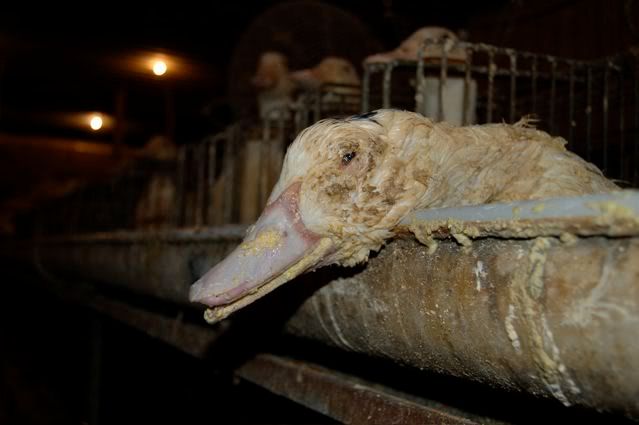http://www.wspa-usa.org/pages/2659_duvets_a_nightmare_for_geese.cfm
http://idfl.com/articles/IDFLLivePlucking11Feb2009.pdf
Reposted by
Kindness of Strangers for the Earth and Animals
Thank you!
Wildlife
Martha
Moonwarriors
LIVE PLUCKING OF GEESE AND EIDER DUCKS FOR DOWN

In a recent Napa Register news article, "The short, sad life of a Hungarian goose," reporter Henry Kamm describes one source of all that down in the stores each winter: "The geese of the Hungarian Soviet Friendship Cooperative Farm live short and unhappy lives. They are hatched without benefit of Mother Goose in ovenlike breeders. Until they are eight weeks old, the goslings are fed either a diet 'good for livers or good for feathers.' Neither is good for the birds' happiness."
If the geese are white, they are destined to be plucked for their down (the soft, fine feathers of young birds), which will go into pillows, parkas and comforters. These geese lead "particularly uncomfortable lives. Four or five times during the short span allotted to them they are plucked." The farm owner conceded that even Western European countries that allow force feeding for pate de foie gras draw the line at plucking the birds alive.
"After the last plucking, when winter approaches and cost accountants say it is more expensive to heat the sheds than the feathers are worth, the geese are slaughtered for their meat."
*Eider ducks. Any of several large sea ducks (genus Somateria) that live in northern regions of Europe, Asia, and North America. Eiderdown is the soft, fine breast feathers, or down, of the eider duck, used as a stuffing for quilts, pillows, etc. (from Webster's New World Dictionary, 1979)

Summary of "Live-Plucked Geese Documented in Video," The Animals' Voice, Jan.Feb.March 1993 (Vol. 6, No. 1), p. 43.
Beauty Without Cruelty Charity in England has obtained color video evidence of the live plucking of geese for feathers and down on Hungarian factory farms. The video shows terrified birds being lifted by their backs and then having all their body feathers ripped out. The frantic geese struggle to escape, causing strained muscles and sometimes broken limbs.
Veterinarians and even geese breeders call this practice "extremely cruel," particularly the plucking itself and the tying of the birds' legs over their backs. Rippers are paid piece rate and therefore speed is of the essence. Experienced rippers can rip up to five ounces of down in three to four minutes—an average pillow takes about 1.5 lbs. of filling. The Hungarian Feather Association confirms that 25,000 tons of goose feathers are exported annually from Hungary (95% of its total production). It estimates 50% of the down and 40%-45% of the feathers are live plucked. The remainder come from slaughtered birds.
Geese normally live in small family units and mate for life, living up to 20 years and flying long distances. But not the geese on Hungarian factory farms, where some 20,000 geese are crammed into a small area. The geese are live plucked two or three times a year before being slaughtered or force fed for another year to produce pate de foie gras (swollen goose liver, a product found in the United States, imported from France). Under normal conditions, a goose develops its first full coat of feathers at about eight weeks old and will molt (gradually shed old feathers and grow new ones like all birds) each year.
Down is in high demand for bedding, and world production adds up to thousands of tons. The main market is Germany. Countries where live-plucking takes place include China, Poland, and Hungary, and allegedly France and Israel.
Synthetic fillings are durable, easier to clean, are less likely to cause allergies, and cost less.
For more information about live plucking or details about the video evidence, write BWC Charity, 57 King Henry's Walk, London N1 INH England.

Live Plucking is Painful. See M.J. Gentle, L.N. Hunter, "Physiological and behavioural responses associated with feather removal in Gallus var domesticus [chickens]," Research in Veterinary Science, Vol. 50 (1990), pp. 95-101.
"Nociceptors [pain receptors] have been identifies in the skin of several avian species [including ducks, geese, and chickens]. The follicular wall of the feather is richly supplied with general somatic afferent (sensory) fibres, and nerves are present in the papilla, pulp and feather muscles. . . The feather is firmly held in the follicle. . . . [F]orce [was] required to remove the dorsal feathers of White Leghorn hens using a steady pull. . . .
". . . In conclusion, from the results presented here and from those of previous experiments it seems likely that feather removal is painful to the bird. Zimmerman (1986) has defined pain in animals as an aversive sensory experience caused by actual or potential injury that elicits progressive motor and vegetative reactions, results in learned avoidance behaviour and may modify species specific behaviour, including social behaviour. Feather removal [experimentally done to Leghorn hens by these researchers] results in tissue injury which gives rise to motor behaviour and cardiovascular changes which when repeated results in stress-induced immobility and thus satisfies most of the criteria in this [M. Zimmerman's] definition of pain."
Posted by Moonwarriors

Reposted by Kindness of Strangers E_CO Member















0 Comments:
Post a Comment